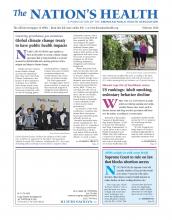The path to good health through fitness can be a challenging but rewarding journey. But if you’re looking for a simple way to break into getting fit, look no further than your own two feet and the path outside your door.

Photo by Monkeybusinessimages, courtesy of iStockphoto.
Walking is an easy and accessible way for people of all ages to get fit. Depending on where you live, walking can even be the healthier alternative to places you normally drive, such as your job or the grocery store.
Walking regularly can help improve your mood, lower your blood glucose and blood pressure and make tasks, such as climbing stairs without feeling winded, much easier, says John Jakicic, PhD, a National Institutes of Health-funded researcher and director of the University of Pittsburgh’s Physical Activity and Weight Management Research Center. In the long run, Jakicic says walking can help reduce your risk of chronic conditions such as diabetes and heart disease.
“There are musculoskeletal benefits as well that result in less muscle soreness, greater mobility and the ability to better perform common daily tasks,” Jakicic says. “There is also a growing body of research that shows that regular activity such as walking can have a significant improvement on one’s cognitive ability, especially with aging.”
If you’re just starting out with a walking routine, aim to walk at a brisk pace for 10 minutes a day, with a goal of reaching 150 minutes of walking per week, Jakicic says. The more you walk, the more you should aim to have multiple 10-minute walks a day, or one longer walk, he says.
“Also, I would recommend that an individual engage in other lighter intensity walking throughout the day when given the opportunity,” Jakicic says. “We are learning more about the detrimental impact of prolonged sedentary activity, so taking a one- to two-minute walk every 30 to 60 minutes can reap health benefits in addition to the bouts that last for 10 minutes or longer.”
If you’re thinking about walking regularly for fitness, it’s important to make sure you’re physically ready. Check with your health care provider about your walking plans if you’ve had health issues related to physical activity, according to the National Institute of Diabetes and Digestive and Kidney Diseases.
Health issues to look out for before you start walking regularly may include pain in your shoulder or neck or feeling out of breath or dizzy. You should also let your doctor know if you are currently managing chronic conditions, such as asthma.
Remember to plan your walking route and share it with friends and family in case of an emergency, according to the institute. Buy a pair of shoes that are comfortable to walk in, Jakicic says. Also wear bright or reflective clothing when walking at night and try to walk with a friend or in a group.
“Walk in areas that are familiar and that you know are safe,” Jakicic says. “Be sure that these areas are well-lighted and have sidewalks for safety. When starting, do so in areas that are flat and as you get in better shape you can start to add a few gradual hills to help you to improve your fitness even more.”
If you use a cane or walker to walk, don’t leave home without it. If you have mobility issues, Jakicic suggests starting by walking up and down the street near your home in case you become fatigued.
“Also, start slowly and gradually move a bit faster as you complete your walk,” he says. “Starting slowly gives your muscles a chance to warm up.”
If you’re unable to walk outside or feel uncomfortable about doing so, get your walking minutes in indoors by moving in place, Jakicic says.
“Turn on the TV and walk during your favorite show, or while watching your favorite show, step in place during the commercials,” Jakicic says. “That will give you five to 10 minutes of activity every 30 minutes.”
Music can also be an inspiration while you walk, though be aware of your surroundings while using headphones, especially when crossing streets.
Walking while you work
You may spend the better part of eight hours sitting in a chair at your office, but there are easy ways to incorporate a walking program at your job. Try hosting a walking meeting instead of a sit-down one in a conference room, according to the Centers for Disease Control and Prevention. If possible, take the stairs instead of your building’s elevator. CDC also suggests taking a walking lunch break. You can also chart how far you walk throughout the day using a portable fitness tracker, such as a pedometer, to track the number of steps you took inside and outside your workplace.
For more tips on walking and your health, visit www.niddk.nih.gov
- Copyright The Nation’s Health, American Public Health Association









